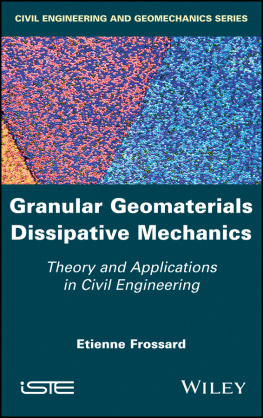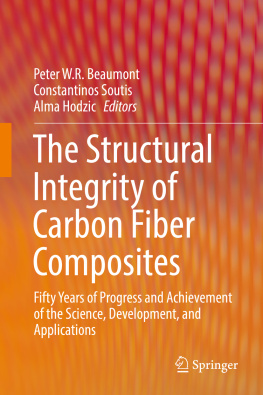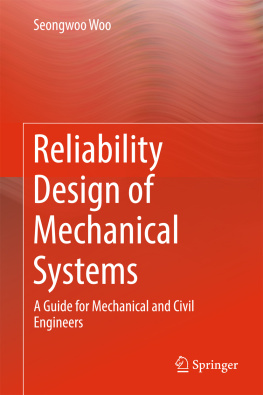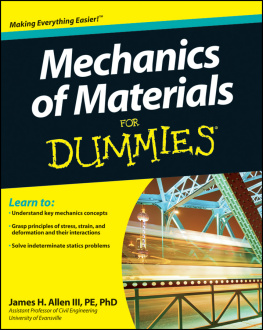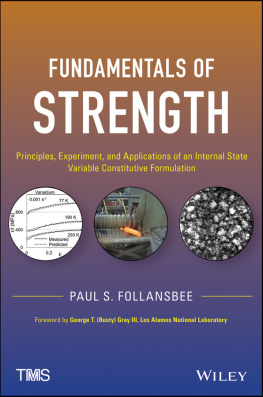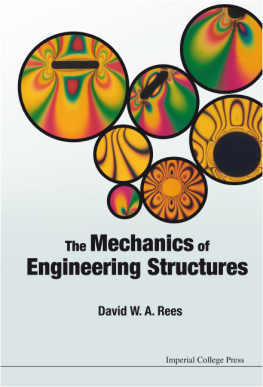
Granular Geomaterials Dissipative Mechanics
Theory and Applications in Civil Engineering
Etienne Frossard
First published 2018 in Great Britain and the United States by ISTE Ltd and John Wiley & Sons, Inc.
Apart from any fair dealing for the purposes of research or private study, or criticism or review, as permitted under the Copyright, Designs and Patents Act 1988, this publication may only be reproduced, stored or transmitted, in any form or by any means, with the prior permission in writing of the publishers, or in the case of reprographic reproduction in accordance with the terms and licenses issued by the CLA. Enquiries concerning reproduction outside these terms should be sent to the publishers at the undermentioned address:
ISTE Ltd
27-37 St Georges Road
London SW19 4EU
UK
www.iste.co.uk
John Wiley & Sons, Inc.
111 River Street
Hoboken, NJ 07030
USA
www.wiley.com
ISTE Ltd 2018
The rights of Etienne Frossard to be identified as the author of this work have been asserted by him in accordance with the Copyright, Designs and Patents Act 1988.
Library of Congress Control Number: 2018952755
British Library Cataloguing-in-Publication Data
A CIP record for this book is available from the British Library
ISBN 978-1-78630-264-9
Preface
Granular materials are present in numerous sectors of economic activity outside civil engineering, from agriculture and agro-industry to pharmaceutical and chemical industries, mining industry, etc. It is estimated that more than two-thirds of raw materials used by world industries are in the form of granular materials, involving gigantic quantities, about 10 billion tons each year, of which processing and transport represent about 10% of energy consumption worldwide [DUR 96]. However, most often, the methods for their process remain rather traditional and lack optimization.
Regarding geomaterials, sand for the construction industry is the second most consumed natural resource after water [LEH 018], and its extraction represents serious environmental issues in certain areas, (including the disappearance of beaches and retreat of shoreline).
Construction of large civil engineering infrastructures commonly involves large volumes of earthfills and rockfills, constituted by sand, gravel, and rock blocks, sometimes up to tens of millions of cubic meters or even more, as in highways or railway platforms, marine infrastructures or large rockfill dams (see .
For this last type of dams, which has become dominant in dam construction today, a major part of the design methods is based on the empirical extrapolation of the standard ones used (in the past) for lower dams. This empirical approach, based on experience, has led to serious technical accidents during commissioning on very high dams in the mid-2000s. As a consequence, concern in the profession has arisen, prompting a return to more rational approaches in design, and particularly Granular Geomaterials Dissipative Mechanics engineering approaches, through structural analysis and relevant material testing as should be the case for any large civil engineering structure. This highlights the need to improve our knowledge of the behavior of the granular geomaterials constituting these infrastructures, as well as of the behavior of these large structures. A way for such improvement may be sought in the integration of physical local phenomena within the materials, up to the scale of the engineering structures.

This book, resulting from a long-term work into the physics of granular materials as well as engineering of large civil works, is an attempt to relevantly move forward proposing a new vision of mechanical behavior of these granular geomaterials, through an original dissipative approach.
After an introductory section on background and key assumptions, the book begins on the main theoretical features of dissipative structures induced by elementary contact friction associated with specific statistical mechanics properties within granular materials in slow motion, and their multi-scale expression into key tensor relations, .
These dissipation relations and related features constitute the backbone of practical applications developed further in this book, starting in focusing on strain localization and shear band detailed features, leading to the process of failure lines generation.
Then, develop practical applications of the main macroscopic energy-dissipation equation and related features to a large set of key properties of great relevance in geotechnical and civil engineering, mainly:
- the failure criterion, resolving into the Coulomb Criterion under critical state;
- the relationships between shear strength and volume changes, expressed in generalized 3D stressdilatancy relations, resolving into classical Rowes relations in particular conditions;
- the characteristic state;
- cyclic compaction features under alternate shear movements;
- the geostatic equilibrium (K0), achieving a relation close to the Jaky formula.
is focused on a wide set of experimental data collected worldwide, covering most of the experimental apparatuses, which thoroughly validate the dissipative approach of the mechanical behavior.
Although a major part of the book is focused on features induced by contact friction, the last part, , presents the key results on practical features resulting from particle breakage, the other main dissipative process after contact friction. These results include explicit incidences of size effects in shear strength, slope stability and safety factors, deformations and settlements in rockfill embankment dams.
Etienne FROSSARD
August 2018
Introduction
I.1. Background
Since Coulombs historical publication of 1773 [COU 73], many investigations have been carried out on the role of physical friction in the mechanical behavior of granular materials. These investigations, supported by pioneering works published by Rankine [RAN 57], Prandtl [PRA 20], Caquot [CAQ 34], Terzaghi [TER 43], and many others, have been progressively incorporated into the body of knowledge of Soil Mechanics, a pillar of civil engineering sciences. However, a direct link between the initial cause friction at the grain contacts and the elements of practical interest concerning the behavior at a macroscopic scale, such as the failure criterion or the 3D stressstrain relationship, has not been clearly established. Significant advances in this direction have been made, such as Rowes stress dilatancy theory [ROW 62], which was enriched later by Horne in 19651969 [HOR 65, HOR 69], or more recent statistical mechanics approaches. Their conditions of validity, however, limited to axisymmetric stress conditions, or 2D granular assemblies made of disks, are more restrictive to apply them in a general case.
The approach presented here has a larger scope and finds a solution to more general 3D quasi-static problems for granular media with grains of random irregular shapes (). It provides us with the access to an explicit expression of a wide set of macroscopic properties such as stressdilatancy laws, failure criterion, strain localization with internal structure of the shear bands, orientation and development of failure lines, the intricate relations between friction, shear strength, and volume changes, and the cyclic compaction under alternate shear motion.
Next page
